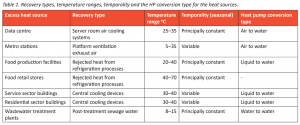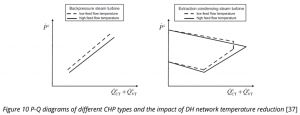What are the different types of heat supply options?
What is district heating and the different types?
What are the different types of heat supply options?
What is the role of district heating in the future energy system?
How to plan low temperature district heating systems?
Introduction
One of the main parts of every district heating system are heat sources. The number of heat sources vary in each network. More heat sources mean that heat supply will be more continuous and more reliable. Reduction of supply temperature enables integration of additional low-temperature thermal sources. While conventional DH typically relies on combined heat and power (CHP) and heat-only boilers, modern DH supply options include low temperature technologies, such as heat pumps.
Different types of heat supply options
Natural thermal sources
Groundwater
Groundwater is commonly used in NTDH systems since it provides relatively constant temperature due to high thermal large thermal capacity of the source.
Advanced page: Natural thermal sources
Urban thermal sources
Waste heat, surplus heat and excess heat
Waste heat, surplus heat and excess heat are synonyms for the heat generated by a process that is not absorbed by that process. The temperature of the waste heat depends on the process generating it. Urban heat sources are often called “LT heat sources” and can be used directly in LTDHNs or high-temperature systems by using a booster HP to bring the heat source to the necessary temperature of the high temperature DHN. The heat to recover can come data centre, service sector buildings (hospital), transport infrastructure (metro tunnel) and water (sea and sewage) [1]

Urban water systems
Advanced page: Urban thermal sources
Supply and boosting technologies
Combined heat and power
Cogeneration, or combined heat and power (CHP), is technology which can simultaneously produce heating and electrical energy. Generally, there are two types of CHP, called back-pressure and extraction cogeneration. In the back-pressure CHP, heating and electrical load are directly correlated, i.e. there is no flexibility in plant operation. Cogeneration only operates if there is district heating load. However, flexibility of such plant can be increased if thermal storage is installed. On the other hand, extraction CHP is relatively flexible since electricity production does not necessarily follow heating load, as shown in Figure 10. The figure shows operating regions for two mentioned CHP types by using so called power-heat (P-Q) diagrams. It can be noticed that P-Q diagram for extraction CHP is a whole operational region, while P-Q diagram for back-pressure CHP is a single line.
Cogeneration systems are an important part of the system since they provide power-heating sector coupling and offer high energy efficiency of fuel utilisation. Nevertheless, it should be mentioned that CHP systems are rarely directly connected to ULTDH or NTDH networks. CHP systems are important for DH systems in energy transition. To fully cover thermal demand of ULTDH and NTDH systems, natural or waste heat sources should be primarily used.

Heat pumps
Heat pumps are crucial part of ULTDH and NTDH systems due to the several reasons. Firstly, coefficient of performance (COP) is increased with thermal network supply temperature reduction. Secondly, they enable power and heating sector coupling. Thirdly, heat pumps can be integrated with thermal storage thus increasing flexibility of the system and enable smoother operation of the district heating system.
Advanced page: Supply and boosting technologies
Thermal storage
Advanced page: Thermal storage